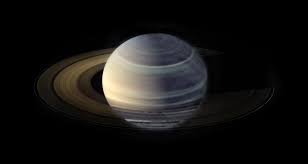Does Saturn have a storm spot?

The Great Red Spot is the largest storm in our solar system. An anticyclone that is over 16,000 km wide-large enough to engulf the entire Earth-the Great Red Spot has been on Jupiter's surface for hundreds of years.
A new study has shown that Satum Jupiters neighbour, also has long-lasting megastorms. While these are less colourful and blander than those on Jupiter, they do have impacts deep in Saturn's atmosphere that remain for centuries. The study was published on August 11 in the journal Science Advances
Similar to hurricanes
Similar to hurricanes on Earth but much much larger, megastorms on Satum occur every 20 to 30 years. The causes for these megastorms in Saturn's atmosphere. which is made up mainly of hydrogen and helium along with traces of methane ammonia and water, remains unknown. Based on radio emissions from Satum. astronomers from the University of California, Berkeley, and the University of Michigan, Ann Arbor, noticed anomalies in the concentration of ammonia gas in the atmosphere. While the concentration of ammonia at mid-altitudes is lower, it was enriched at lower altitudes. 100 to 200 km deeper in the atmosphere.
Precipitation and re-evaporation
The researchers were able to connect this to the past occurrences of megastorms in Satum's northern hemisphere. According to them, ammonia is being transported from the upper to the lower atmosphere. This effect, which they believe can last for hundreds of years, occurs through the processes of precipitation and re-evaporation.
Additionally, this study reveals that Saturn and Jupiter are very dissimilar despite the fact that both gas giants are made of hydrogen gas. The tropospheric anomalies in Jupiter have been connected to its zones (whitish bands) and belts (darkish bands), while those on Saturn are caused by cyclones.
These differences between Saturn and Jupiter challenge scientists on what they know about the formation of megastorms on gas giants and other planets. Understanding this would not only further our knowledge of terrestrial meteorology, but may also inform us as to how they are formed and studied on exoplanets in the future.
Picture Credit: Google